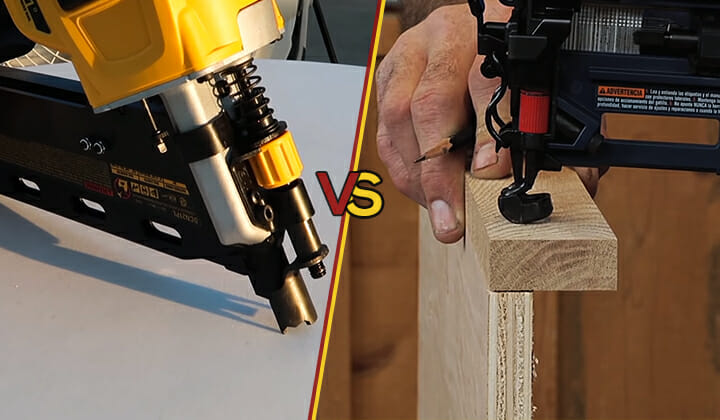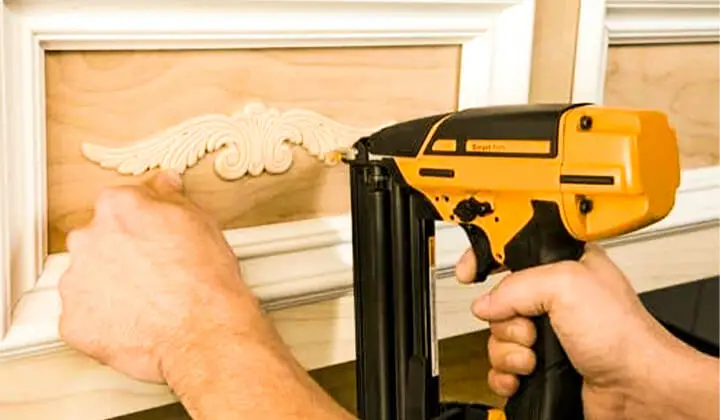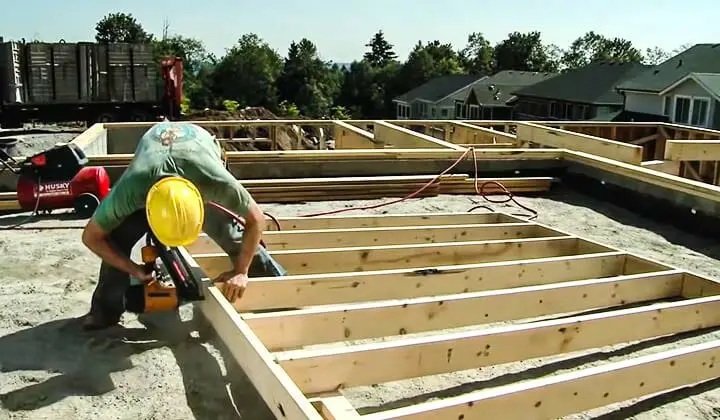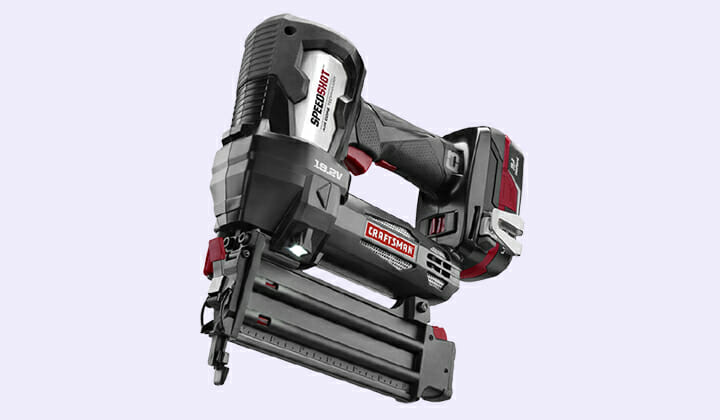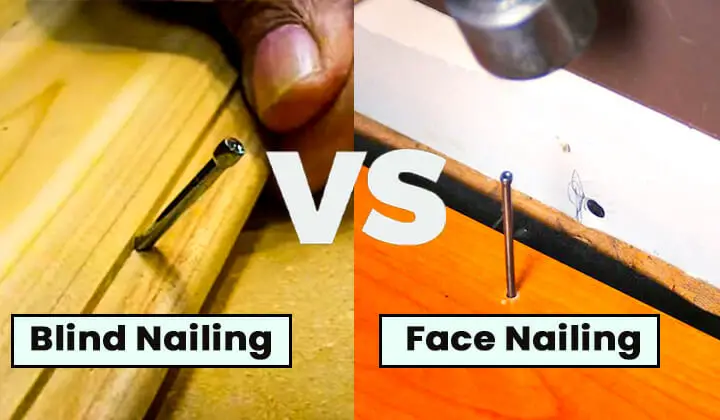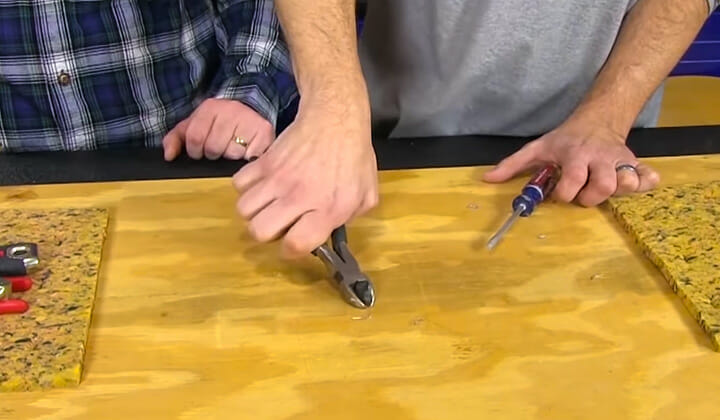Which Nail Gun Do I Need According To the Types Of Nail Guns
Pneumatic nail guns would be the right choice for more heavy-duty professional work. But for more flexibility, you can get the cordless one too. But there’s more than just these to meet your specifics. So, at the end, it is which nail gun do I need?
Let’s get a deeper look, shall we?
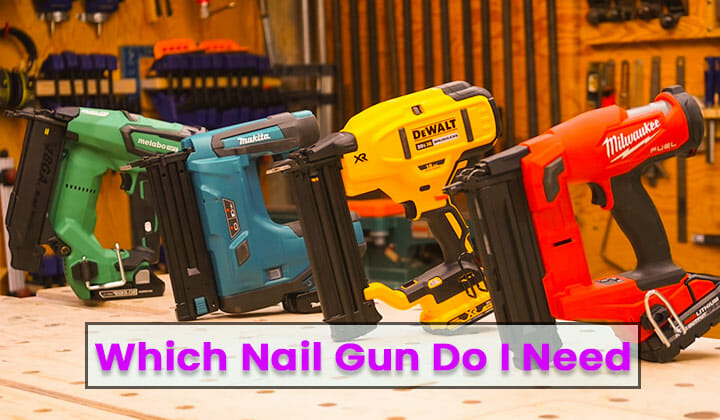
Table of Contents
Which Nail Gun Do I Need | Types of Nail Guns Explained
Types of Nail Guns According to Application
There are different variations for nail guns according to various tasks. They are best suited for the job they have the functionality to do.
Framing Nail Gun
As you get the impression from the name, this type of nailer is best suited for framing jobs. They are for heavy-duty wood framing operations. They use three and ½ inch nails in length for the job. Whether it’s a framing task or a sheathing task, you would want this tool by your side.
Flooring Nailers
These nailers are to help you in grooving the floorboard quickly & easily. Hardwood flooring couldn’t get more manageable for you. You just need to hold the machine against the edge of the board & whack the nail in with a mallet. This saves you a lot of time & strength.
Brad Nailers
Brad nailers are a popular choice for DIY tasks. They are a lightweight nailer that uses 18 gauge ⅝ inch to 2-inch nails. Moreover, they offer a tool-free depth adjustment as well as being an excellent option for smaller projects. Any small cabinetwork or woodwork is easy to do through this nail gun.
Finish Nailer
The best option for indoor trim and molding work would be the finish nailers. They use 15 to 16 gauge nails at the length of 1” to 2½” inches. They are widely used for crown molding or small carpentry work. Plus, they also offer tool-free depth adjustment according to the surface.
Types of Nail Gun According to Power Source
Power sources determine the nail gun’s mobility & the amount of work it can handle. You need to be familiar with the power source of your nail gun.
Pneumatic Nail Gun
A pneumatic nail gun uses pressurized air that comes from an air compressor. Usually, you would find the compressor power in PSI(pounds per square). Air compressors can handle a lot of loads. They are capable of heavy-duty handling tasks.
But as you are using an air compressor & hose, you are sacrificing the mobility of your work. But you have the necessary driving force to complete your project without the need of sitting for the nail gun to charge up again.
Battery Fuel Cordless Nail Guns
These guns have a small battery and a fuel cartridge to operate. From brad nailers, and finish nailers to other types of nailers are also available in the cordless form. The mechanism is straightforward. The chamber fills up with gas from the cartridge. Then the battery helps to create a tiny spark to light the gas. This gives the driving force to drive the nails.
Battery Cordless Nail Gun
Batteries power these cordless nail guns. You don’t need any cords or hoses to function with this type of nail gun. Hence they provide the mobility to work more flexibly around the project.
But you will not have the same driving force as the pneumatic ones. They are great for those who are looking into working on smaller projects. If the charge on the batteries finishes, you need to wait for them to recharge. Suitable for DIY activities.
Nail Gun Firing Method
There are different firing methods you should be familiar with before starting your project. Being aware of the firing method can dismantle the chance of any accidental firing. Let’s take a look, shall we?
Bump Fire Method
This firing method lets you fire nails in quick succession. You compare it with a machine gun-type function. As long as you press down the trigger, with each bump of the safety tip on the surface, it will keep firing. This is a professional approach because it can get difficult to control the gun.
Single Firing Method
For the single-fire method, you need to operate the safety tip & the trigger at the same time. For all the coming nails, you keep the safety tip pressed against the surface. The rest of the work is by pressing the trigger whenever you need to nail it.
Full Sequential Firing Method
This method allows you to have a safer approach to driving nails. You need to press both the safety tip & trigger to fire each nail. This method doesn’t let you fire as quickly as the bump fire method, but it is safer to operate in this way.
Nail Type
Stick Nail
These nails come in a single flat row. Well, they come in three collations: wire plastic & paper weld. You’ll find them together by these elements. Hence, you can put them in quickly.
Coil Nail
These nails are within a string of elements. They are inserted in a round holder where you insert the coil of nails. Coil nails allow you to put as many as 350 pins at a time. You can use coil nailers for these nails.
Nail Gauge
Not all guns have the same length of nails. You have to have the proper knowledge of what size of nails you need for your work. Such as 15 or 16-gauge supported guns can take up to 2 and ½ inch-long nails. 16 gauge nails are a good choice as they are thick enough for most work.
18 gauge nails are used for more delicate work. They are thinner in size compared to 16-gauge nails. So they are perfect to use while trimming or molding.
23 gauge nails are also in the market. They have a particular purpose for work. If you need fine-nailing and fixing work, then 23 gauge pins are suitable for the job.
Remember, it’s not the nail gun that selects the nails. It’s the nails that pick the nail gun.
Some Other Extra Features
These are some of the more common features you would want your nail gun to have. They would undoubtedly make your life easier. Let’s take a look.
Tool-Free Jam Clearing
Often nails can get clogged in the magazine. This can cause you to lose a lot of time learning the complicated jam. But if your nail gun has a tool-free jam clearing, then you just need to open the magazine & clear the blockage by hand. This a handy feature to have as you will face this problem with nail guns
Depth Adjustments
This feature allows you to control how far the nails drive into the surface. Sinking the nails too deep can ruin the floor or wood you are working with. A depth adjustment wheel can make your working experience much better as you can work on many projects with different nail depths.
Exhaust System
Exhaust systems allow you to direct the air of the tool. Many nail guns have a unidirectional flow, while some have 360-degree airflow systems. This can help keep all the debris away from the workspace and keep the dust away from the tool.
Ergonomic Handle & Carry Case
The handle of the nail gun needs to be ergonomic. You will be operating the tool with your hand, so keeping the device steady requires a firm grip. Make sure the handle has a good grip & patterns to keep it in your hands.
Carrying the tool & other accessories with it can become hectic. Most manufacturers give carrying cases to transport everything in one. Make sure yours has one too.
Nail Gun Weight
Most people avoid talking about this point. But in our perspective, this point affects your work more than you think because you are using the guns constantly with your hand.
A heavy can lead to arm fatigue very quickly. If the fatigue doesn’t go away, you won’t get any work done at all. So make sure you are compatible with the tool’s weight as you will be working with it all day long.
Frequently Asked Questions (FAQ)
What nailer is best for toenailing?
Toe nailing is a technique that allows you to drive a nail at an angle. This is to create joints at an angle so that they can stay together. The best type of nailer for this job would be the framing nailer, as it can provide the necessary angles.
What kind of nail gun do I need for molding?
16 gauge nails would give you a lot more flexibility in working with moldings. 18 gauge nailers are for more delicate work. But with the 16 gauge, you can work with different types of moldings.
Is brad nailer a good option for hardwood floors?
You can use a brad nailer to work on a hardwood floor, but you would have a tough time going through the hardwood floor. It is preferable to use a flooring nailer for the job.
Can a nail gun be dangerous to the user?
Despite all the benefits it gives to the users, it can become a potential threat if you are not careful. More than 42,000 people in the US go to the emergency for nail gun-related injuries. You have to be careful handling this powerful tool.
Conclusion
Nail guns are engineered to do a specific set of applications. Now that you have the proper knowledge to see what you need for your work, it’s better, to sum up, your needs first. Then match the list with what type of nail gun is best for your job.
